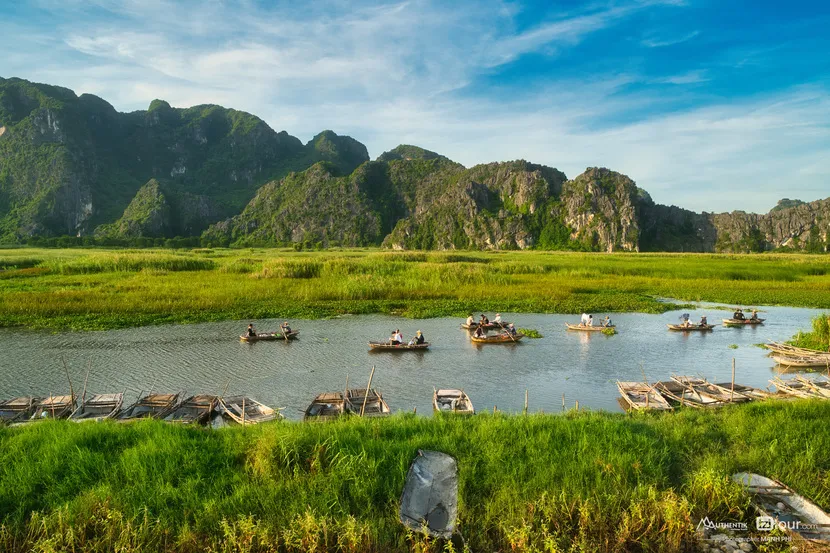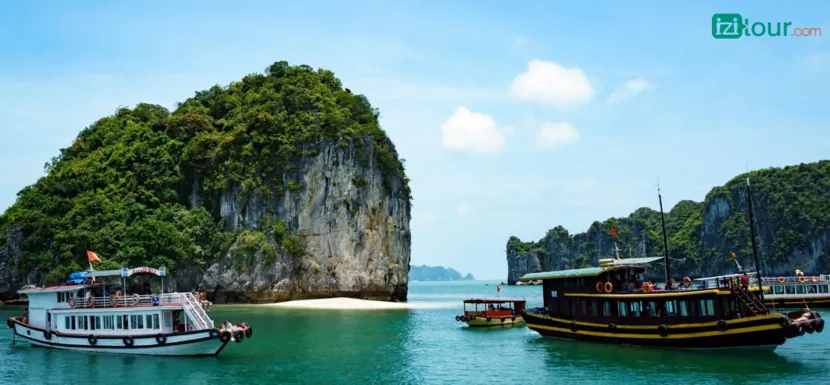Vietnam, with its diverse topography and latitudinal span, boasts a fascinating range of climates from North to South. The monsoon winds, like a skilled conductor, orchestrate the unique symphony of weather across the country.
These monsoon seasons play a significant role in shaping Vietnam's climate and weather patterns. In this Southeast Asian nation, monsoons are a year-round phenomenon, though their intensity varies throughout the year. They bring refreshing rains to the Mekong Delta, cool breezes to the Ha Giang Geopark, and contribute to the country's stunning natural landscapes. Understanding the seasonal monsoon in Vietnam will help you choose the ideal time to travel, pack accordingly, and fully appreciate the beauty of each region. So, let's find out the different types of monsoon winds in Vietnam, when and where they occur, and how they might influence your trip.
1. Monsoons in Vietnam
Vietnam's climate is strongly influenced by two distinct monsoon seasons: the winter monsoon (northeast monsoon) and the summer monsoon (southwest and southeast monsoon). In Vietnam, monsoons typically bring moisture and rain during the summer, while in winter, they bring cold, dry air.
2. The Winter Monsoon Season in Vietnam
The Winter Monsoon occurs from November to April
This monsoon is active during the winter months, from November to April. However, the exact start and end dates can vary from year to year. Sometimes the northeast monsoon arrives early, sometimes late, and sometimes it ends early.
The winter monsoon originates from the Siberian high atmospheric pressure and enters Vietnam from the northeast. It predominantly affects the North Vietnam (from the 16th parallel northwards). As it moves south, the wind is modified and largely blocked by the Bach Ma mountain range near Hue. Only strong surges of the northeast monsoon can influence the southern regions, bringing occasional cool days.

Vietnam monsoon direction at different times of the year
The Winter Monsoon doesn't blow continuously throughout the winter but rather in bursts
While generally cold, the northeast monsoon isn't uniform throughout the winter. Early in the season, it brings cold, dry air, while later in the season, it becomes cold and humid. As it moves south, the northeast monsoon also changes character, becoming warmer and more humid. Even during this cold season, sunny days will still occur as the monsoon comes in waves, interspersed with periods of trade winds.
The Winter Monsoon primarily affects northern Vietnam
If you're traveling to northern Vietnam, be aware that the monsoon can bring a chilly winter to the region, lasting 2-3 months. Temperatures can drop below 20°C (68 °F), and in some places, below 15°C (59°F). Higher mountainous areas like Sapa can experience frost, freezing fog, and even snow.

Local people enjoy playing with snow (Sapa)
Due to the changing nature of the northeast monsoon, the first half of winter (from November to February) sees the monsoon blowing over land, bringing cold and dry weather with clear skies to northern Vietnam. This is a great time to visit Hanoi, Ninh Binh and the surrounding areas if you're comfortable with colder climates.
In the latter half of winter (from February to April), the northeast monsoon blows over the sea before reaching Vietnam, picking up warmth and moisture. This results in cold, humid weather with overcast skies and drizzle in northern Vietnam.
The further south it travels, the weaker the northeast monsoon becomes. Then it's largely blocked by the Bach Ma mountain range, so Hue experiences only a slightly cool winter. The northeast monsoon has almost no impact on southern Vietnam, so from Da Nang, Hoi An, Nha Trang, Ho Chi Minh City, Phu Quoc and the Mekong Delta, the winter is almost not cold. Instead, the weather is hot and dry, stable throughout the season, with a pronounced dry season.

Boat trip to visit Tra Su cajuput forest (Mekong Delta)
What to Pack for Your Trip During the Winter Monsoon Season
The northeast monsoon season in Vietnam typically brings cold, dry weather with occasional drizzle. To ensure a comfortable and enjoyable trip, consider packing the following:
- Sweaters, thermal shirts, thick jackets (padded jackets, wool coats, windbreakers, etc.).
- Long pants, thermal leggings.
- Should wear many thin layers of clothing instead of one thick layer of clothing to easily adjust when the temperature changes.
- Umbrella or thin, light raincoat.
- Waterproof shoes, easy to move.
- Clothes should be made of sweat-absorbent material to avoid catching a cold when sweating.
- Prioritize closed shoes with good grip for easy movement on slippery roads.
- Skin cream, lip balm (dry weather can cause your skin to crack and peel)
- Sunscreen (because even in winter, UV rays can still be harmful to the skin)
While the northeast monsoon brings cooler temperatures, there will still be sunny days, so you won't need all of these items all the time. However, being prepared will make your trip much more enjoyable. Be sure to check the weather forecast before your trip to pack accordingly.

Warm sunny days in the middle of winter (Location: Van Long Nature Reserve)
3. The Summer Monsoon Season in Vietnam
The Summer Monsoon occurs from May to October
The southwest monsoon or summer monsoon season occurs from May to October, particularly during the summer months.
The summer monsoon is formed due to low atmospheric pressure over the Indo-Myanmar region, drawing winds into Vietnam from the southwest or southeast. Originating over warm tropical seas, it brings with it a large amount of moisture, resulting in a hot and humid summer with rainfall in many areas. Strong southwest winds often accompany drizzling rain and storms. Rainfall during this season is substantial, accounting for over 80% of the annual precipitation.
During this monsoon season, temperatures are high throughout the country, exceeding 25°C (77°F) in lowland areas like Hanoi, Ninh Binh, Halong, and Ho Chi Minh City. The weather is often cloudy, but after the rain, the sky clears, and the sun shines brightly, creating a cycle of rain and sunshine.
The central coastal region (Hoi An, Da Nang, Nha Trang) experiences less rain and enjoys clear skies during this period, making it ideal for beach vacations and basking in the sun.

Halong Bay's sky is clear after the rain
Monsoonal rains nourish rice paddies
The rains brought by the southwest monsoon play a crucial role in providing water for agriculture, especially rice cultivation, contributing to bountiful harvests. As a result, the rice-growing season in many areas begins in late May or early June, with harvests taking place in September and October. The timing can vary depending on whether the area cultivates one or two rice crops per year.
Traveling during this season offers the chance to admire from the lush green paddies to golden rice paddies on the terraced fields of Mu Cang Chai, Hoang Su Phi, Y Ty, Sapa, and Pu Luong. These terraced fields, stretching across the mountain slopes, create a breathtaking, picturesque landscape. Another must-see is the Mekong Delta, the largest rice-producing region in the country.
The cooling Summer Monsoon provides relief from the summer heat
Blowing in from the sea, the southwest monsoon brings moisture and prolonged periods of heavy rainfall, cooling the air and reducing temperatures during hot summer days. It helps to disperse air pollution, improving air quality in urban areas. The abundant rainfall from the southwest monsoon also sustains natural ecosystems, including rainforests, rivers, and lakes, resulting in lush green forests and thriving flora and fauna.
Rainy season with the Southwest Monsoon
While the southwest monsoon brings welcome relief from the heat, it also ushers in the rainy season. In early summer, the southwest monsoon brings heavy rainfall to the southern plains (Ho Chi Minh City and surrounding areas), Phu Quoc Island and the Central Highlands. Prolonged heavy rain can lead to landslides in some areas. Travelers should be cautious when visiting regions with steep terrain and unstable soil conditions in the northern mountainous provinces such as Ha Giang, Cao Bang, Lao Cai, Lai Chau, Son La, and Dien Bien.

The beauty of Ho Chi Minh City in the rainy season
What to Pack for Your Trip During the Summer Monsoon Season
The southwest monsoon season in Vietnam lasts from May to October, coinciding with summer, and brings hot, humid weather with plenty of rainfall. Here are some essential items to pack for your trip:
- Clothing should be made of cool, sweat-absorbent materials to keep the body dry and comfortable
- Choose bright-colored clothes to avoid absorbing heat, helping you feel cooler.
- Sudden showers are typical of the southwest monsoon season, so don't forget to bring a raincoat or umbrella
- Choose comfortable, cool, easy-to-move shoes, especially sandals or sneakers
- To protect your skin from the harmful effects of UV rays, choose a sunscreen with a high SPF and water resistance
- Always carry water with you, especially on days with lots of outdoor activities
Hope the above information will help you have a fun and safe trip during the Vietnam’s monsoon season!
To explore Vietnam at ease:
If you are looking for a private tour related to this article, please let us know exactly what you need or see our available tour programs at the best price. IZITOUR specializes in organising private tours for small groups and tailor-made tours, ensuring travelers get the most authentic experience. Whether it's a day trip in Hanoi, a Northern adventure, or a multi-week vacation exploring Vietnam, we've got you covered. Our local travel experts are ready to craft unforgettable journeys that cater to your interests.
Discover Vietnam itineraries & best prices
See more:





















 TRAVELERS' CHOICE 2025
TRAVELERS' CHOICE 2025 



02 Comments
France
Vietnam
La mousson d’hiver du nord-est (de novembre à avril) affecte surtout le Nord du Vietnam. Plus elle descend vers le Sud, plus elle est bloquée par la chaîne de Bach Ma. Ainsi :
- Hué connaît un hiver légèrement frais.
- À partir de Da Nang et plus au sud (Hoi An, Nha Trang), la mousson d’hiver n’a quasiment aucun effet et le temps reste chaud, sec et stable durant toute la saison.
Write Reply